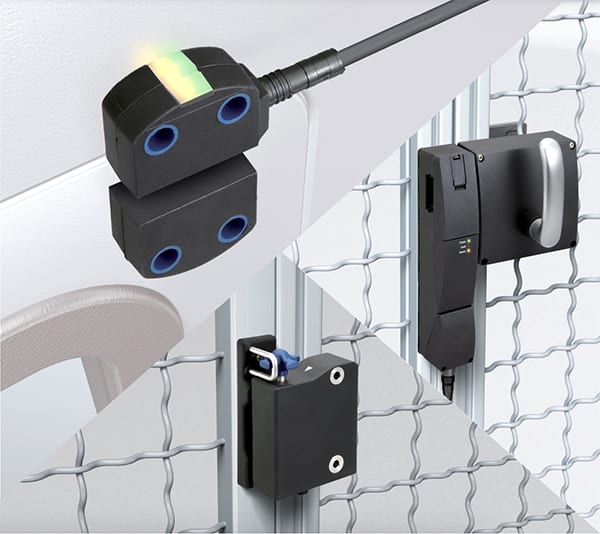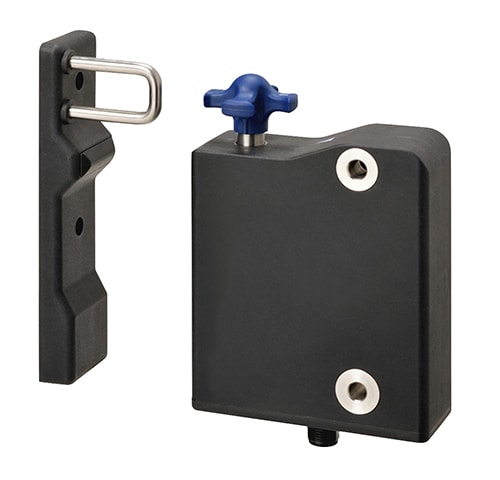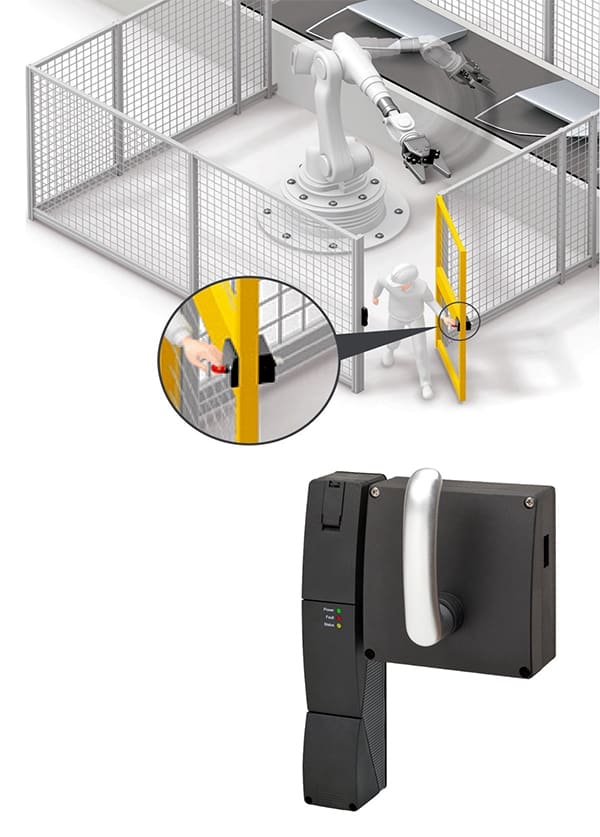Five key considerations when specifying safety door switches for your next project, with the Omron D41 Series as an example.
Pamela Horbacovsky, Omron Product Manager – Safety, and Kenny Heidel, National Channel Account Manager, Omron Automation
The basic role of a safety door switch is easy to grasp. It provides a physical barrier that prevents people from bypassing the safety systems that protect them from bodily harm and nearby equipment from damage. For example, a door switch could be installed on a movable guard, which is a specialized door that protects machinery and personnel in industrial and functional safety applications.
Safety system defeats can have significant consequences. These include compliance violations, reductions in the system’s performance level, and the possible injury or even death of an operator. In other words, if someone finds a way — either accidentally or deliberately — to open a moveable guard that should not be opened, the integrity of the entire safety system is at risk.
Given these high stakes, safety system designers must not overlook the value of a reliably secure safety door switch. However, as is the case with many electronic products, choosing the right one can be difficult due to the numerous options available. In this edition of the RS “Ask the Expert” Series, we will use Omron Automation’s D41 Series safety door switches to depict five key considerations that will help you specify the best door switch for your unique safety system.
Application Environment Considerations

Omron’s D41 Series safety door switches are designed to prevent system defeat and bypass and are available in three variants for versatility: the D41D Series (top), the D41G Series (right), and the D41L Series (bottom).
Safety systems can be found in virtually every industry. As a result, the elements used to comprise these systems must be versatile enough to satisfy a wide range of application environments. Omron’s D41 Series safety door switches exemplify this versatility, offering several different versions designed to overcome issues such as limited space and aesthetic disruptions (D41D), the accumulation of water, food, and dust and exposure to detergent (D41L), and power failures (D41G).
The D41D high-coded, non-contact safety door switch, for example, comes in three different actuator options — standard, flat, and miniature — to ensure effective installation, accurate detection, and appealing aesthetics in challenging application environments. Such environmental characteristics can include narrow spaces, corners, and swinging, sliding, and transparent glass or acrylic movable guard doors. The D41D is also ideal for use in machines with limited space and narrow openings, such as flow pack machines.
Depending on the application, safety systems can also be exposed to any number of environmental challenges, including heat, cold, weather, electromagnetic interference, washdowns, and chemicals used to satisfy strict hygienic requirements.
In these cases, customers should prioritize safety door switches that are rated for a wide range of operating temperatures, equipped with shielding or sealing features, or made with rugged or easy-to-clean materials.
One such example is Omron’s D41L high-coded guard lock safety door switch. Optimized for harsh environments and hygienic applications, the D41L prevents the accumulation of water, food, and dust thanks to its smooth surfaces with no keyholes. It is also ECOLAB-certified for detergent resistance, which enables thorough cleaning in hygienic environments like those in medical applications or food, beverage, and pharmaceutical manufacturing facilities.
Special Feature Considerations
Although the basic function of a safety door switch is relatively simple, the technology has evolved over the years to provide a range of features that solve unique application challenges and alleviate high-risk concerns. Omron’s D41G high-coded guard lock safety door switch, for example, offers a manual emergency release mechanism that prevents people from being locked inside hazardous areas in the event of a power failure. It is also equipped with coded RFID tags that enable non-contact entry and exit for personnel cleared for access, reliably prevent defeat and bypass, and ensure the highest level of protection.

Additional features of the D41G include slim housings designed to match the aluminum profiles used in guarding applications, integrated ergonomic door handles, three different actuator options for left-hinged, right-hinged, and sliding doors, and compliance with ISO 14119 Type 4 and ISO 13849-1 PLe Category 4. Large equipment facilities that operators need to enter, such as machine tool and robot cells, are ideal applications.
Purchasing Budget Considerations
While it is arguably true that no expense should be spared when it comes to health and safety, the reality is that safety systems must be developed within the confines of a budget. As a result, the specification process is not as simple as choosing the most advanced, highest-rated safety door switch available. Instead, it is often a matter of choosing the switch that offers the best price-to-performance ratio within the allotted budget.
It is also important to note that just because one safety door switch costs more than another, it is not necessarily better or more reliable. For instance, one may have advanced features that are not required for the application at hand. To avoid misallocating the purchasing budget, customers must have a firm grasp of their application demands. Omron and RS are ready to help with this need by providing technical product support specialists who can discuss application demands and help identify suitable solutions.
Installation Budget and Process Considerations

Omron’s D41G Series safety door switches (bottom) feature a manual emergency release mechanism (top) that prevents people from being locked inside hazardous areas in the event of a power failure that renders the non-contact RFID entry and exit feature nonoperational.
Budget considerations do not end at the purchasing phase. Installation costs, which include both time and money (e.g., the amount of time required to install the switch and the labor costs to complete that task), are just as important to account for as part cost, and they can vary dramatically depending on the complexity of the safety system setup or the project’s degree of difficulty. As such, choosing a supplier with proven design and manufacturing experience and an extensive product portfolio can often help to minimize these costs, as can specifying a more feature-rich safety door switch optimized for easier installation.
For example, all three D41 Series switches — the D41D, D41L and D41G Series — are a part of the expansive D41 product family, which is specially designed to be easy to install, pair, monitor, and troubleshoot. By virtue of its versatility, it also allows customers to source various solutions from within the same product family. Being able to satisfy the disparate demands of extensive safety systems with as many as 31 switches using solutions from a single product line simplifies the system design and installation process and significantly reduces maintenance, repair, and operating (MRO) costs. This helps stretch limited customer budgets much further over time.

D41 Series features including large actuator tolerances (left), mechanisms that enable easy latching force adjustments (center), and LED displays (right) simplify installation, pairing, monitoring, and troubleshooting processes.
Troubleshooting and Maintenance Considerations
When purchasing new equipment of any kind, it can be easy to overlook characteristics like the ease of maintenance since the specification process is so focused on finding the best solution for the challenge currently at hand and repairs tend not to be required until much later in a product’s lifespan. However, even the most secure and reliable safety systems require regular maintenance to ensure peak performance.
Each safety system has its own unique specifications and processes for periodic maintenance checks and troubleshooting. Much like the installation process, both the difficulty and the overall costs of these tasks can vary dramatically from system to system. For this reason, considering ease of maintenance characteristics during the specification process can help save time and money in the future. For example, Omron’s D41 Series safety door switches incorporate a three-color LED indicator panel capable of communicating 11 different statuses to speed up and simplify the troubleshooting process.
In Conclusion
A safety system is only as secure as its weakest link. While safety door switches may not be the first component that comes to mind when you think of the systems that protect personnel and equipment in large equipment facilities, such as machine tooling and robot cells, they are every bit as important to the successful operation of the system as more obvious components like physical barriers and alarms. As such, it is vital to consider the five characteristics addressed here — application environment, special features, purchasing budget, installation budget and process, and troubleshooting and maintenance — to ensure that you specify the best safety door switch for your unique system.
Additional Links:
- Omron Automation microsite
- Omron’s D41 Series safety door switches
- All Omron Safety products
- Omron Automation website







